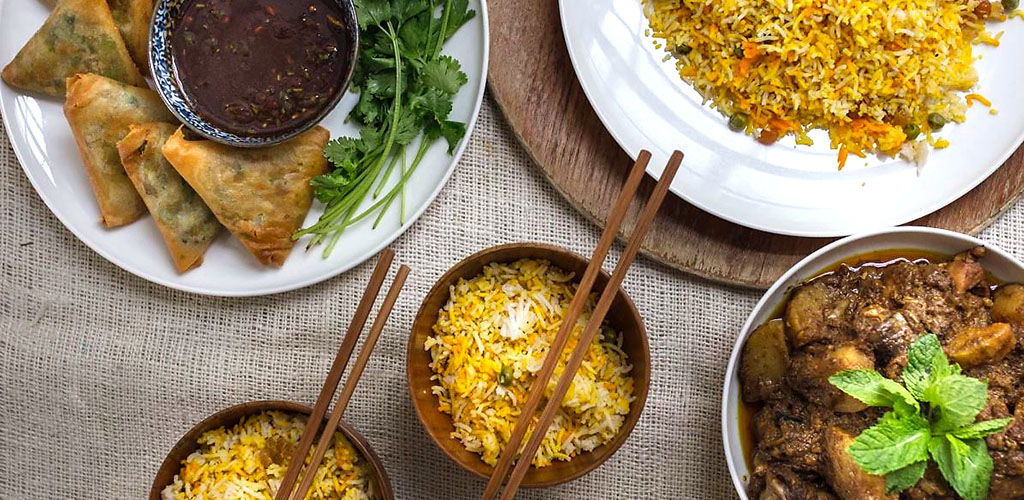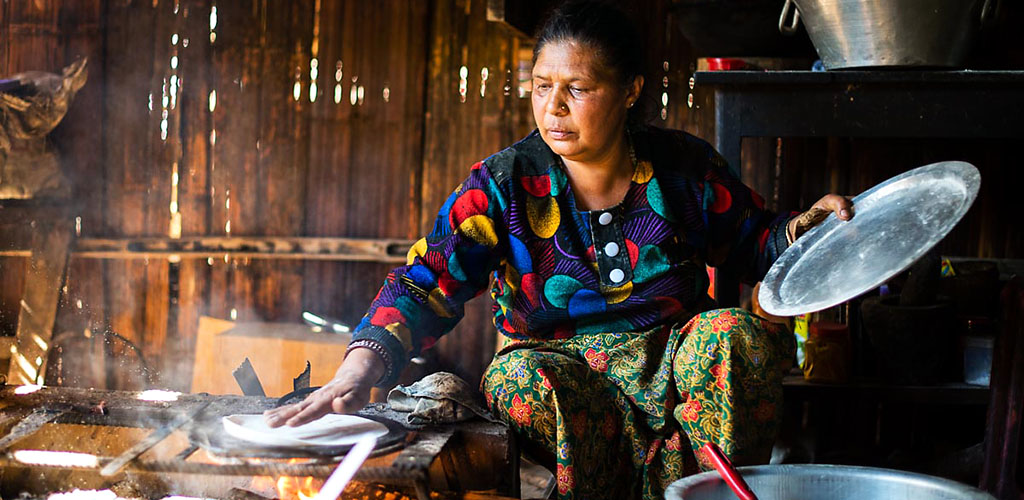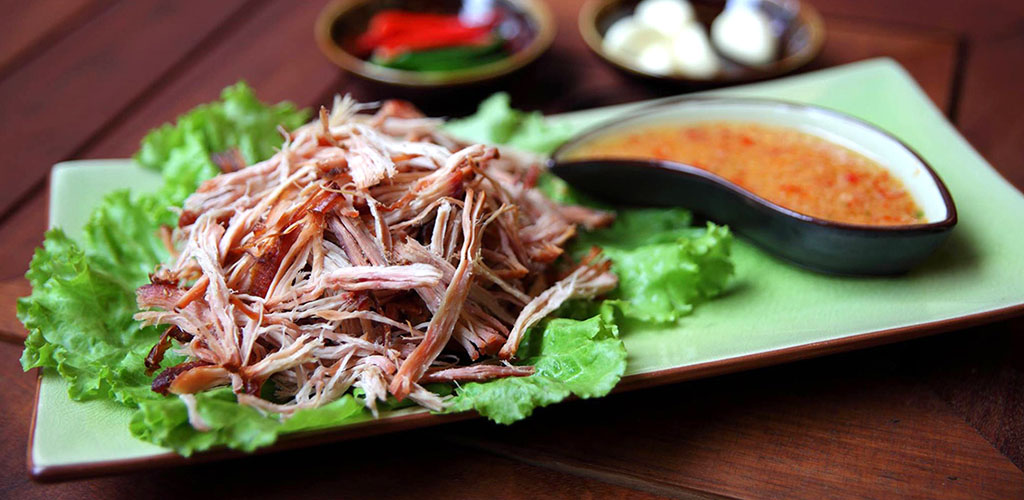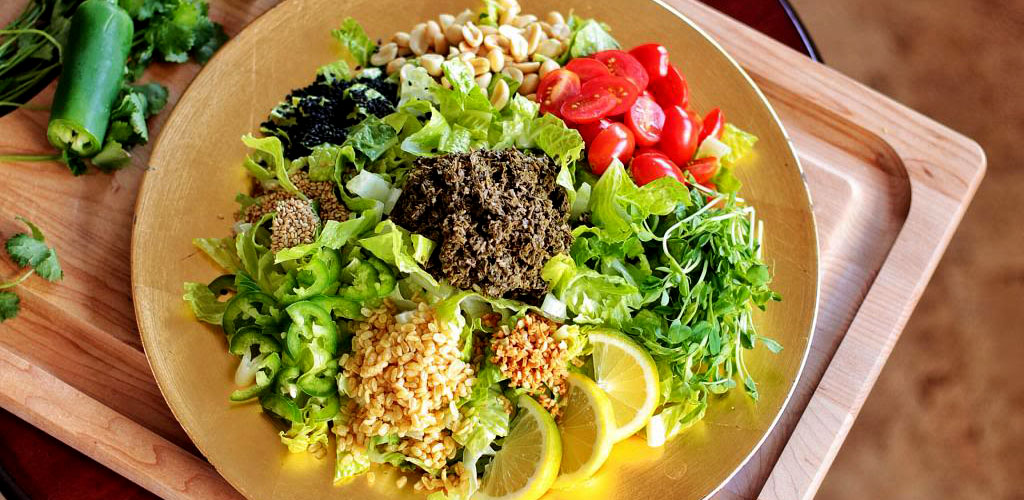Myanmar Food Tours
The warmth of a samosa in your hand, plucked from a legendary street cart. Discovering and tasting sweet white wine cultivated on the shores of Inle Lake, the stilt-rowing fishermen silhouetted on the water below. Learning how to cook fresh fish soup, inhaling the scent from a spice market, perfecting lemongrass sliders during a lesson on contemporary Burmese cuisine. The country’s food surprises and our Myanmar food tours celebrate the authenticity that can be found when you dig beneath the surface. And if you’re wanting something a bit closer to home, we know a colonial hotel that still serves up an iconic afternoon tea experience.
Much More Than A Myanmar Food Tour
Cooking classes and street food tours don’t always spring to mind when thinking about Myanmar, a land known for Buddhism and temples. And if you were to take a Myanmar food tour, what cuisine would be the focus? The fiery Indian flavors, broths and soups of the north, perhaps an exoticism more commonly known in Thailand? Explore the country and you’ll find that the food varies widely, so long as you know where to look. We were one of the first companies to operate private Myanmar tours and our owner-operated approach has always sought out the best local culinary experiences. So while great food might not be your reason for visiting the country, it is likely to be one of your enduring memories.
Introduction to Burmese Cuisine
Sharing borders with China, India, Laos and Thailand, Burmese cuisine is inevitably influenced by the spices, seasonings, ingredients, and cooking styles of its neighbors but also by the myriad of local ethnic minorities. It is the way that these "foreign" ingredients are combined which makes Burmese dishes unique and diverse.
 No doubt if you're not very familiar with Burmese cuisine, you may likely know of Burmese rice in its various forms, such as black and red. However, Burmese cuisine is mostly noted for its liberal use of fish products including fish sauce and ngapi (fermented seafood). The national dish, mohingha (right), is made with fish broth, for example.
No doubt if you're not very familiar with Burmese cuisine, you may likely know of Burmese rice in its various forms, such as black and red. However, Burmese cuisine is mostly noted for its liberal use of fish products including fish sauce and ngapi (fermented seafood). The national dish, mohingha (right), is made with fish broth, for example.
Burmese cuisine also includes a variety of salads (a thoke), typically centered on one main ingredient, ranging from starches like rice, wheat and rice noodles, glass noodles and vermicelli, to potato, ginger, tomato, kaffir lime, lahpet (pickled tea leaves), and ngapi (fish paste). These salads have always been popular as fast foods in Burmese cities.
The Indian influences found in Burmese versions of dishes are among our favorites, including samosas, biryani, curries, spices, chutney, and breads, such as naan and paratha, and chapatis at outdoor cafes where lassis and sweet milk tea are a delicious treat. In reality, there is no national Myanmar cuisine. The country is a patchwork of over a hundred indigenous ethnic groups, and their very own food cultures have influenced countless dishes that nowadays can be enjoyed across the country. But if we had to generalize, it perhaps wouldn’t be too much off the mark if we said that Myanmar cuisine lies somewhere between northern/northeastern Indian, southern Chinese and northern Thai cooking.
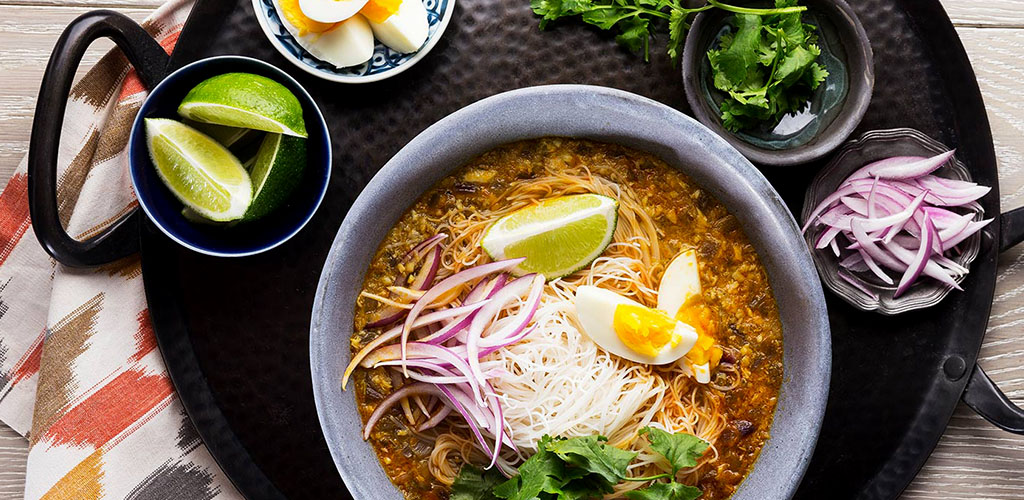
What's important to know about dining in Myanmar? For picky eaters, international restaurants outside of larger hotels are scarce. Delicious and often decent meals can be had at backpacker cafes but also botique hotels (even if you are not staying there) the local chapati cafes and teashops.
Culinary Customs: The country's diverse religious makeup influences its cuisine, as Buddhists avoid beef and Muslims pork. Beef is considered taboo by devout Buddhists because the cow is highly regarded as a beast of burden. Vegetarian dishes are only common during the Buddhist Lent (Wa-dwin), a three-month Rains Retreat, as well as Uposatha sabbath days. During this time, only two meals (i.e. breakfast and lunch) are consumed before midday to observe the fasting rules (u bohk saunk) and abstinence from meat (thek that lut, literally 'free of killing') is observed by devout Buddhists. Throughout the rest of the year, many foods can be also prepared vegetarian on request, although like other countries in Southeast Asia , the bulk of Burmese food is prepared with fish or meat broth bases. Many ethnic groups prepare at least one inherently vegetarian dish (notably cuisine from the Shan people).
Recomended Reading

Naomi Duguid's BURMA: Rivers of Flavor is the definitive text on Burmese cuisine also delves into culture in a beautifully designed and presented book. The book was a winner of the IACP Cookbook Award for Culinary Travel in 2013. Some interesting comments by Naomi about the book include:
"You've been traveling in Burma since 1980; what changes have you observed?
In the eighties Burma was a country that had been closed off from the rest of the world. There was an old-world charm to that, but also a lot of suffering and poverty.
Then came the military crackdown of 1988 and more than twenty years of real fear and oppression. That was the vibe when I started work on this book in early 2009. Though people might have a sense of fun and ease in the privacy of their own homes, they were cautious and serious out on the streets and wary of being seen talking to a foreigner.
Now that has changed, in a dramatic and wonderful way, and very quickly. Late in 2011, with reforms and a relaxation of censorship from the top, people lost their fear. They suddenly became confident that Burma was truly emerging from the black hole of oppression. Now there is laughter and open discussion in tea shops and on the streets.
In researching and writing the book, I wanted to celebrate the richness of the food cultures of Burma and the vibrancy of individuals. I decided that there was no room for the army in the kitchen, so I put all the history of bad times at the back of the book.
I've seen the start of a dramatic long-overdue transformation over the last year. But there are still huge issues in Burma: attacks by the army on the people of Kachin State (a place rich in resources that shares a long border with China); unresolved conflicts in many border areas; and real questions about who is going to benefit from the exploitation of the country's natural resources.
The world has realized Burma's geopolitical importance, especially givens its rich oil and gas reserves. No wonder foreign companies and governments now want access. Daw Aung San Suu Kyi has been calling for a freshly negotiated political agreement among all the ethnic communities, including the majority Bamar people, and she is also asking that investors focus on building capacity in Burma, from education to roads and services. She's right on. Let's hope the world listens.
What is the dish from Burma that anyone and everyone must rush home and make tonight?
"The Lemongrass Sliders (p. 192) are a great and easy introduction to the possibilities in the book, and so are many of the salads. The Ginger Salad (p. 48) is one of my favorites. For those who like chile heat, my favorite condiment, Tart-Sweet-Chile-Garlic Sauce (p. 36), is another good place to start."
On video: We also enjoy Luke Nguyen's YouTube video on preparing a traditional Burmese dish in Yangon.
More on Burmese Cuisine
It’s rare and exciting when a "new country" opens up, especially that there are preciously few regions left that can still be considered untrammeled and diluted by globalization. And certainly, one of the true great pleasures of visiting a new country is to discover its cuisine - and this is where Myanmar shines as well. Thai, Indian, Korean, Japanese and Chinese restaurants are ubiquitous around the world. Myanmar eateries on the other hand are still relatively sparse outside the country, although the U.S. and Canada do have their fair share due to having accepted many refugees from Myanmar. Burma Superstar in San Francisco's Richmond district is one fabulous example. Of course, most places have adjusted their dishes to suit local taste preferences and like any other cuisine, its a delight to sample the “true cuisine of Myanmar” in its native setting.
Asian Table Manners
Like in practically all of South, Southeast and East Asia, dining is primarily a social affair that more often than not involves groups of family and friends. Locals appreciate invigorating table talk and will try to make their meal a group experience whenever possible. Myanmar cuisine is thus primarily geared towards promoting this concept. Individual dishes are rarely the huge portions with which we are familiar in the West, because even the ordering process is a communal affair. Each diner will select one or two dishes from the menu. Although not a hard and fast rule, the order would ideally comprise dishes with the major taste groups of sweet, salty, sour, bitter, spicy-hot and savory.
Each dish typically arrives in its own small bowl or on a plate together with serving spoons and is placed in the middle of the table, whereas individual eating plates and cutlery are also placed in front of each diner. Unlike in the West, steamed rice is regarded as the main meal, while all those other delectable goodies are merely seen as side dishes to complement the rice. Also of notion is that all dishes are brought to the table almost simultaneously. There are no separate courses, and soups are treated (and eaten) like any other dish together with rice. After each diner has received a generous heap of rice, it’s time to dig in. Use the serving spoons to ladle small amounts from the dishes onto your own plate. But not too much... which is considered gluttonous and rude (you may always get more a second helping).
Table knives are not used (nor are they necessary), because the meats and vegetables are typically already cut into bite-sized pieces. Instead, take the spoon in your right and the fork in your left hand. Use the fork to push a small portion of rice and a few morsels of the side dish from your plate onto your spoon. Never use your own eating spoon to fetch more food from the communal bowls which is bad manners. Surprisingly, chopsticks are generally only used with noodle soups.
This style of eating brings the obvious benefit that diners can enjoy a wide spread of different dishes during one single meal. If you don’t fancy the taste of one or another single dish, it’s perfectly alright not to partake in it and stick to the ones you like. By the way, it’s considered very polite if your host occasionally puts some of the tastiest morsels on your plate. It’s an expression of great affection. You may reciprocate by doing the same to your host, although it’s by no means compulsory. Also, never pull the dish that you personally contributed to the communal order in front of you in a move that indicates that you’re not willing to share it. Again, this would not only be seen as very rude, but also as anti-social and selfish.
Apart from those dishes that usually form part of a communal meal, there are also many ‘single-plate’ dishes, i.e. complete meals in themselves that are typically not shared by eaten by the ordering person alone, often for breakfast or lunch. Many eateries feature ‘buffet-style’ set-ups, with rows of trays holding different dishes displayed on a glassed-in counter. These are Myanmar’s version of fast food restaurants. Simply walk up to the counter and point out the dishes you want. The serving staff will ladle a small portion of each indicated dish onto a plate of steamed rice. If you’re in a group, you can of course order individual bowls of each dish.
After having introduced you to the basics of local table manners, it’s finally time for the low-down on the best of the best of Myanmar cuisine.
Myanmar’s Favorite Dishes
Mohinga - Originally a Bamar dish (the Bamar are arguably the largest ethnic group and inspired the British to name their formercolony “Burma”), this is nowadays considered Myanmar’s unofficial ‘national dish’. It’s basically a soup consisting of an opaque fish broth with rice vermicelli and the tender hearts of banana tree stems and seasoned with plenty of onions, garlic, fresh ginger and lemongrass. It’s usually served with hard-boiled eggs and fried fish cake. The dish is also available ‘dry’, i.e. without the fish broth.
Kat Kyi Hnyat - Especially in coastal areas (and Myanmar’s got a lot of these!) you’ll find seafood dishes like this one, a mouth-watering concoction of broad rice noodles mixed with a variety of fish and shellfish, on occasion some pork or beef, crunchy bean sprouts and long beans and scrambled or fried egg. If you’re familiar with Thai food, it closely resembles pad thai (Thai fried noodles).
Mont Di - The paradigm of Myanmar fast food - and extremely popular for breakfast and lunch - is this dish of rice vermicelli laced with different condiments (the assortment may change from food shop to shop) like tiny dried fish, fish paste, fish powder, ground peanuts, nga pi (chili and shrimp paste), shredded fresh vegetables, vegetable pickles and usually a side dish of slightly sour soup.
Htamin Jin - Another ethnic dish (this time the Shan), consists of fermented rice mixed and kneaded with fresh fish meat, mashed potatoes (or taro) and tomato paste, then formed into a patty and fried. It’s garnished with crispy-fried sliced garlic and chives and often served with a side dish of roasted chili flakes in oil. Tear of a piece of the cake and dip it in the fiery chili oil, if you wish.
Dan Bauk - Indian influence is obvious in this Myanmar-style biryani, a plate of saffron-colored rice mixed with vegetables (peas, beans, carrots, etc.) and spices (star anise, curcuma, turmeric, etc.) and topped with a very tender, succulent, marinated, oven-baked chicken thigh or sometimes a piece of equally falling-off-the-bone mutton. Small side dishes of Mango chutney or pickle, fresh mint leaves and/or a spicy chili dip is often served as an accompaniment.
Si Byan - Myanmar brims with all kinds of curry dishes, and this is just one of them. Meat or fish is cooked in a special curry paste with lots of oil and water. The curry is ready when all the water has evaporated, resulting in a thick, very aromatic gravy. You are not required to eat all the oil that swims on the surface. Just spoon out the meat with some of the curry gravy and mix it with your steamed rice.
A Country of Salads
When we’re talking about Myanmar cuisine, it’s impossible to ignore the huge variety of salads (dishes that normally end with the word thote). But before we proceed you better discard all preconceived notions you might have about salad. Myanmar salads have absolutely nothing in common with mayonnaise-smothered, oil and vinegar-drenched, western-style vegetable mixtures. Instead, they more often than not use quite surprising ingredients and dressings.
Lahpet Thoke - Without doubt the most famous - and popular - salad of them all is made of tea leaves fresh from the bush and pickled (yes, you’ve read that right!) with a variety of crunchy bits (dried shrimps, fried peas, toasted sesame, sliced tomatoes, green chili, fresh or preserved ginger slices, etc.) dressed with lime juice and peanut oil and seasoned with salty fish sauce.
Khauk Shwe Thoke - This savory and very satisfying salad consists of yellow wheat noodles, shredded cabbage and carrots and crunchy, dried shrimps. Again the dressing is made of lime juice, peanut oil and fish sauce.
Htamin Thoke - It would be surprising if Myanmar cuisine didn’t feature at least one salad making use of the national diet’s cornerstone, rice; and here it is. Boiled rice is mixed with glass noodles, chickpea flour, fermented beancake, dried shrimps, chili and crispy-fried garlic, dressed with lime juice, tamarind juice, fish sauce and peanut oil and garnished with fresh coriander leaves. A revelation!
Thayet Chin Thoke - Shredded green (as in ‘unripe’) mangos join sliced onions, green chilis, roasted peanuts and toasted sesame in this delectable salad, its dressing again provided by lime juice and peanut oil.
Thinbaw Thi Thoke - Thailand visitors have certainly made acquaintance with that country’s famous papaya salad som tam (occasionally a.k.a. papaya pok-pok). This is Myanmar’s version and uses fried garlic flakes instead of fresh garlic cloves.
You may have realized it by now (or not), but this article could continue almost ad finitum by listing a plethora more Myanmar dishes. Alas, our space is limited. Embark on your personal culinary discovery tour of Myanmar. Be intrepid and curious in your quest. The rewards are great, as a whole new world of epicurean delights awaits you at virtually every corner in this enchanting country formerly known as Burma.
Interested in our culinary trips? Join the best culinary group tour in Vietnam with our partner Atlas Obscura, or contact us for a private tour in Myanmar, Thailand, Cambodia, Laos and Vietnam.

Why choose Indochina Travel? We take you to places, organize experiences, and introduce you to local people that no one else does. Whether celebrating an anniversary, honeymoon, or planning a family journey, our journeys offer unforgettable experiences in Myanmar, the Land of Gold.
Read on to plan your perfect Myanmar tour? Contact us by clicking here or calling us in San Francisco at (415) 418-6800 .
